|
|
Post by oldcyansilverback on Jan 16, 2023 6:24:42 GMT -5
The Seven Species Of New World VulturesThe New World Vultures, also known as the condor family, are scavengers who live in the warm, temperate areas of the Americas. 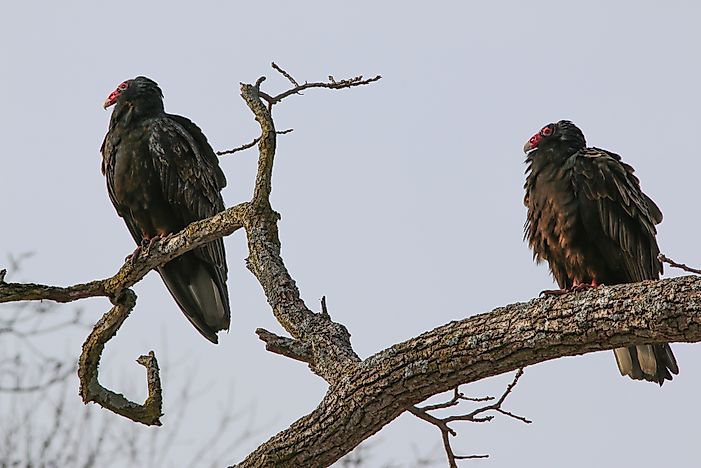 The New World Vultures, also known as the condor family, refers to vultures belonging to the family Cathartidae. The family is represented by seven species belonging to five genera. These birds live in the warm, temperate areas of the Americas. The New World vultures are scavengers who feed mainly on carcasses of dead animals. They detect the carcasses using their keen sense of smell and sharp eyesight, unlike the Old World vultures which lack the former ability. Here is a list of the seven species of New World vultures and important features associated with them: 7. King Vulture 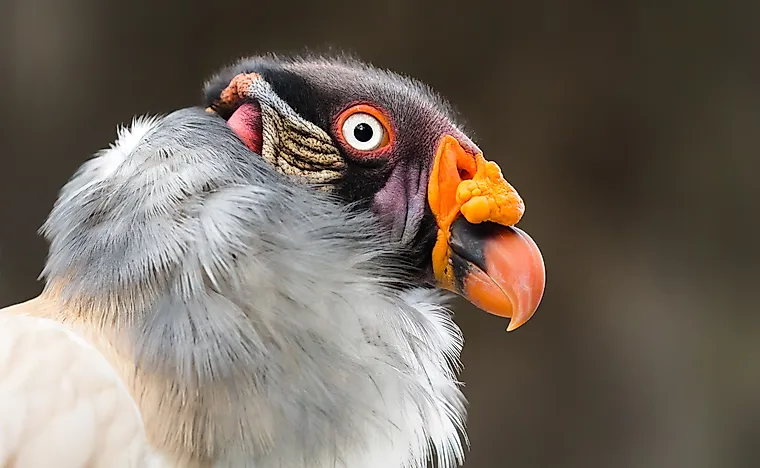 The king vulture (Sarcoramphus papa), the only surviving species of the Sarcoramphus genus, is a large bird that lives in South and Central America. The range of the bird extends from northern Argentina in the south to southern Mexico in the north. Here, the bird inhabits the tropical lowland forests. The bird is predominantly white with gray to white tail, ruff, and flight feathers. The birds feed on carcasses, often displacing the smaller vultures from the site. The King vulture is known to live for about 30 years in captivity. Even though these birds have been classified as Least Concern, their numbers are fast falling due to habitat loss. 6. Andean Condor 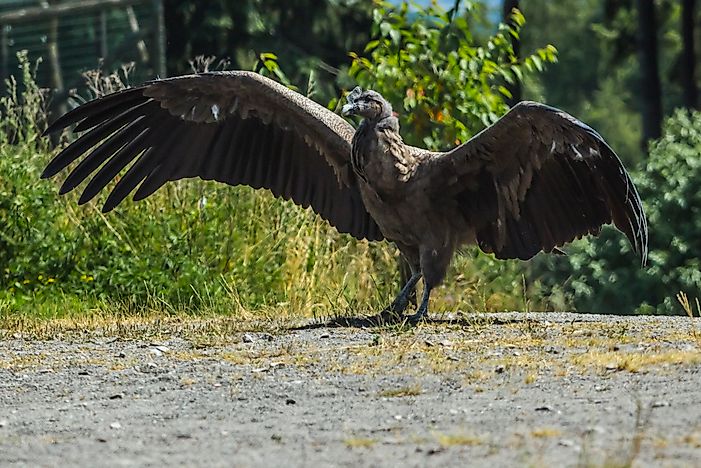 The Andean condor (Vultur gryphus), the only species of the genus Vultur, lives in South America. It is the world’s largest flying bird. The bird lives in the Andes Mountains of South America and the adjacent Pacific coasts. The Andean condor is black in color with a ruff of white feather surrounding the neck base. The head and neck of the bird are a dull red color and lacks feathers. The males of this species are larger than the females. The Andean condor is mainly a scavenger that prefers to feed on carcasses of large mammals like cattle or deer. The birds nest at elevations of up to 16,000 feet. Inaccessible rock ledges are the preferred nesting locations of these birds. The Andean condor is one of the world’s longest living birds with a lifespan of more than 70 years. The bird is regarded as a national symbol of many South American nations and is an integral part of the mythology and folklore of the region. IUCN classifies this bird as threatened. Habitat loss and secondary poisoning from hunter-killed carcasses are killing these birds. 5. California Condor 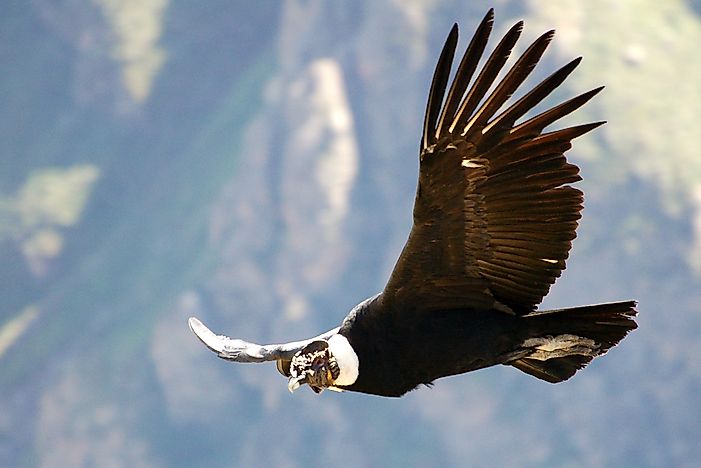 The (Gymnogyps californianus) is the largest terrestrial bird in North America. The bird became extinct in the wild in 1987 during which time the few remaining in the wild were captured to eliminate the possibility of complete extermination of the species. The captured birds were bred in captivity and individuals were then released in the wild. The birds have been released in the Grand Canyon area and the Zion National Park, and a few other locations in northern Arizona and southern Utah. Some individuals have been released in northern Baja California and the coastal mountains of California. Today, these birds are still critically endangered. The birds have a black plumage, bald head, yellow to bright orange skin color, and white patches on the underside of wings. It feeds on carrion and lives up to 60 years in the wild. 4. Greater Yellow-Headed Vulture The greater yellow-headed vulture or the forest vulture (Cathartes melambrotus) lives in the tropical moist lowland forests of South America. The birds are fairly large in size, weighing around 1.65 kg and with a wingspan of 166178 cm. The bird locates carcasses by spell and sight and then feed on the carrion. The bird is dependant on the larger vulture species like the king vulture to access the interiors of the carcass. The beak of the greater yellow-headed vulture is not strong enough to tear through the hide of the larger mammals. The birds build their nests on cave floors or stump hollows and feed their young by regurgitation. 3. Lesser Yellow-Headed Vulture 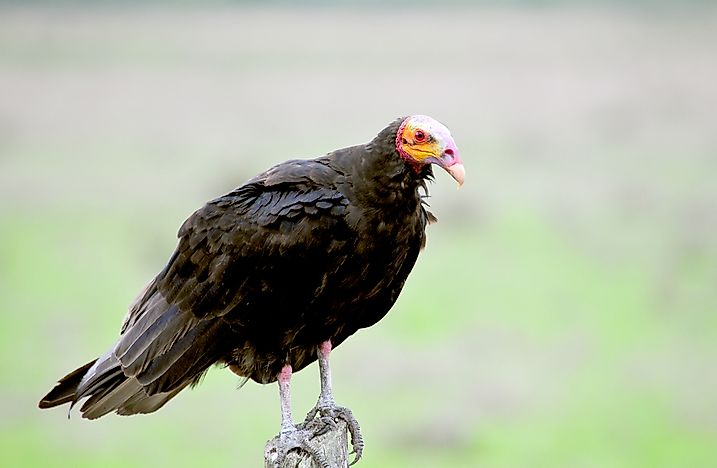 The lesser yellow-headed vulture, also known as the savannah vulture (Cathartes burrovianus), is a bird living in Central America, South America, and Mexico. Within its range, the bird inhabits swamps, grasslands, degraded forests, and seasonally flooded lowland habitats. The bird is large in size with a wingspan of 150–165 cm. The savannah vulture has a black plumage, and featherless head and neck which are pale orange in color with specks of red or blue. Like other species of vultures, it feeds on carrion and locates food by smell and sight. It is also dependant on large vultures to open the hides of larger carcasses. 2. Turkey Vulture 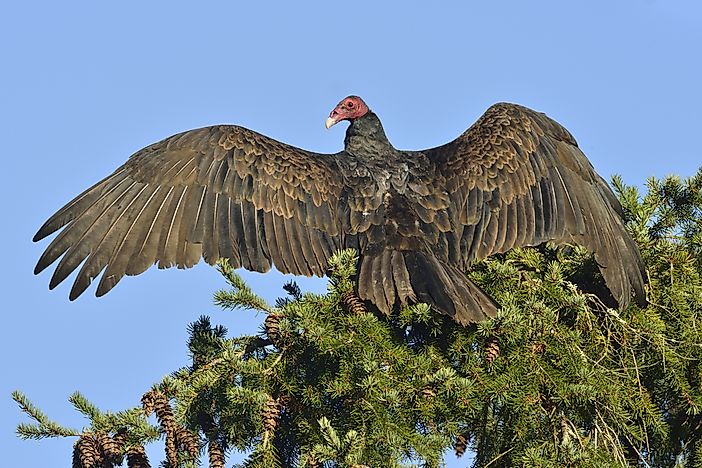 The turkey vulture or the turkey buzzard (Cathartes aura) has a wide range stretching from southern Canada to South America’s southernmost tip. Within its range, the bird inhabits a wide variety of habitats including shrublands, pastures, deserts, subtropical forests, etc. The turkey vulture feeds almost exclusively on carrion and has a strong eyesight and sense of smell. The bird is named after the turkey bird since its bald red head and dark plumage closely resembles the appearance of a wild male turkey. 1. Black Vulture 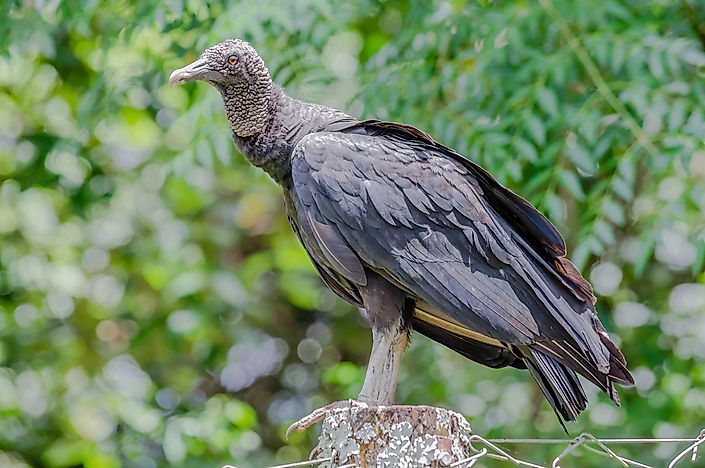 The black vulture () is a species of vulture whose range extends from southeastern US to Central Chile and Uruguay. The bird inhabits relatively open areas within its range. It has a wingspan of 4.9 feet, black plumage, bare neck and head that is grayish-black in color, and a hooked, short beak. The scavenger feeds on carrion as well as eggs of young, newborn animals. The birds living in the vicinity of human localities also feed on garbage in garbage dumps. www.worldatlas.com/articles/the-seven-species-of-new-world-vultures.html
|
|
|
|
Post by oldcyansilverback on Jan 16, 2023 6:25:27 GMT -5
Old World vulture.
Old World vultures are vultures that are found in the Old World, i.e. the continents of Europe, Asia and Africa, and which belong to the family Accipitridae, which also includes eagles, buzzards, kites, and hawks.
Old World vultures are not closely related to the superficially similar New World vultures and condors, and do not share that group's good sense of smell. The similarities between the two groups of vultures are due to convergent evolution rather than a close relationship. They were widespread in both the Old World and North America, during the Neogene. Old World vultures are probably a polyphyletic group within Accipitridae, with palm-nut vulture, Egyptian vulture and Bearded vulture separate from the others. Most authorities refer to two major clades: Gypaetinae and Aegypiinae (Aegypius, Gyps, Sarcogyps, Torgos, Trigonoceps and possibly Necrosyrtes). The former seem to be nested with Perninae hawks, while the latter are closely related and possibly even synonymous with Aquilinae. Within Aegypiinae, Torgos, Aegypius, Sarcogyps and Trigonoceps are particularly closely related and possibly within the same genus.
Both Old World and New World vultures are scavenging birds, feeding mostly from carcasses of dead animals. Old World vultures find carcasses exclusively by sight. A particular characteristic of many vultures is a semi-bald head, sometimes without feathers or with simple down. Historically, it was thought that this was due to feeding habits, as feathers would be glued with decaying flesh and blood. However, more recent studies have shown that it is actually a thermoregulatory adaptation to avoid facial overheating; the presence or absence of complex feathers seems to matter little in feeding habits, as some vultures are quite raptorial.
Population Declines, Threats, and Implications
Population Declines
More than half of old world vulture species are listed as vulnerable, endangered, or critically endangered by the IUCN Red List. Population declines are caused by a variety of threats that vary by species and region, with most notable declines in Asia due to diclofenac use. As vultures play an important role in ecosystems, their population decline can have cultural, public health, and economic implications for communities. Within Africa, a combination of poisonings and vulture trade (including use as bushmeat and traditional medicine) account for roughly 90% of population declines.
Threats
Diclofenac
Diclofenac poisoning has caused the vulture population in India and Pakistan to decline by up to 99%, and two or three species of vulture in South Asia are nearing extinction.[8] This has been caused by the practice of medicating working farm animals with diclofenac, which is a non-steroidal anti-inflammatory drug (NSAID) with anti-inflammatory and pain-killing actions. Diclofenac administration keeps animals that are ill or in pain working on the land for longer, but, if the ill animals die, their carcasses contain diclofenac. Farmers leave the dead animals out in the open, relying on vultures to tidy up. Diclofenac present in carcass flesh is eaten by vultures, which are sensitive to diclofenac, and they suffer kidney failure, visceral gout, and death as a result of diclofenac poisoning.
Meloxicam (another NSAID) has been found to be harmless to vultures and should prove an acceptable alternative to diclofenac. The Government of India banned diclofenac, but over a year later, in 2007, it continued to be sold and remains a problem in other parts of the world.
Other Poisoning
Poisoning accounts for a majority of vulture deaths in Africa. Ivory poachers poison carcasses with the intent of killing vultures, since vultures circling over a carcass alert authorities to a kill. Vultures are also unintentionally poisoned when they consume carcasses of predators that have been poisoned by livestock farmers.
Traditional Medicine / Belief Use
Vultures in Africa are killed for use in traditional medicine as part of the African vulture trade. Vulture heads are believed to provide clairvoyance.
Bushmeat Consumption
Another part of the African vulture trade is use for bushmeat consumption.[7]
Electrical Infrastructure
Collisions with electrical infrastructure account for roughly 9% of vulture deaths in Africa.[7] Some organizations in South Africa are working with power companies to mitigate this threat.
Implications
As vultures play an important role in ecosystems, their population decline can have cultural, public health, and economic implications for communities.[7]
The decline in vultures has led to hygiene problems in India as carcasses of dead animals now tend to rot, or be eaten by rats or wild dogs, rather than be consumed by vultures.[11] Rabies among these other scavengers is a major health threat. India has one of the world's highest incidences of rabies.[12]
For communities such as the Parsi, who practice sky burials in which human corpses are put on the top of a Tower of Silence, vulture population declines can have serious cultural implications.
Conservation Efforts
A project named "Vulture Restaurant" is underway in Nepal in an effort to conserve the dwindling number of vultures. The "restaurant" is an open grassy area where naturally dying, sick, and old cows are fed to the vultures.[13][14]
Organizations across Africa are working to reduce threats to vulture species with efforts to change and create policies to protect species both at the national and international scale.
|
|
|
|
Post by oldcyansilverback on Jan 16, 2023 6:26:14 GMT -5
The Old World Vultures These unloved birds! Often wrongly accused of crimes they are not committed, or considered as dirty, ugly, dangerous, carriers of diseases or viruses… to make a long story short, the vultures disturb! Whatever country they are living, these large birds are suffering or have suffered persecution, direct or indirect poisoning and shooting. They are unloved, but why? The vultures are scavengers. All the countries where they are living need them to clean the nature. They feed on carrion of all types, from large mammals to small birds or fish according to the range. In the Himalayas, the vultures were in charge of feeding the bodies of dead people because the wood was rare and expansive, and the frozen soil did not allow burying the corpses. The Eurasian Griffon Vulture and Cinereous (Monk) Vultures fed the flesh and the Bearded Vultures took the bones. This practice is still used today, but much more rarely. The vultures are mentioned in legends and myths of several countries There are numerous examples. They can be related to the death, the war or the blood, due to their feeding habits. But their large size and powerful stance are also associated to protection and defence of the young, whereas their ability to soar high in the sky, make them nearer to God. Formerly, these birds were respected and revered by humans. Why are they killed today? Only one way to know them better: to study them! 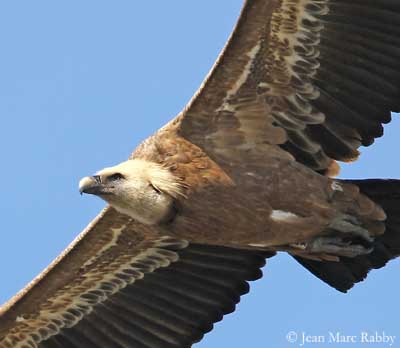 Eurasian Griffon Vulture Gyps fulvus The vultures belong to the large family Accipitridae, divided in nine natural groups. They are the third group, including today 16 species and 9 genera. They do not have their own family, in spite of their different appearance and behaviour compared to the other birds of prey. The most important genus Gyps, includes eight “typical” vultures’ species as we always have imagined these birds before to see them. With the other eight genera, they share several peculiarities related to their appearance, their feeding and scavenging habits. 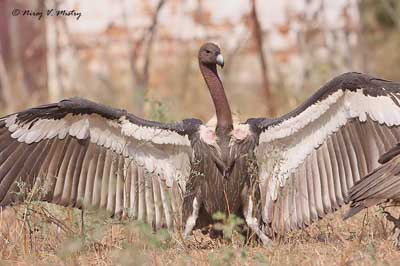 White-rumped Vulture - Gyps bengalensis 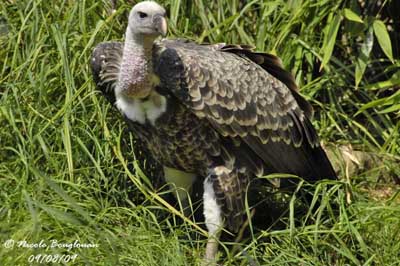 Rüppell's Vulture - Gyps rueppellii The vultures of the genus Gyps are large raptors, with a wingspan from 200 to 260 cm, and a weight of about 6000 to 12 000 grams. They have similar plumage pattern but more or less dark upperparts. The eight species have dark brown to blackish flight feathers, pale buff to white ruff, and sparsely covered in whitish to brownish down neck and head. The bare face varies from pinkish to bluish through greyish and brownish. The strong hooked bill is usually horn-coloured, more or less pale or dark according to each bird. The eyes are dark brown to yellow. Legs and feet are greyish to blackish. All are scavengers, feeding at large carcasses, often with other species. 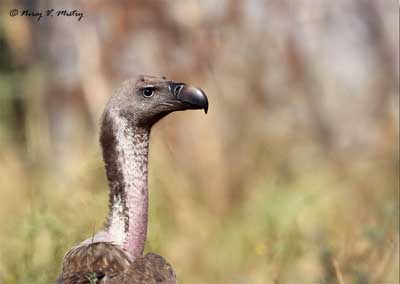 Long-billed Vulture - Gyps indicus 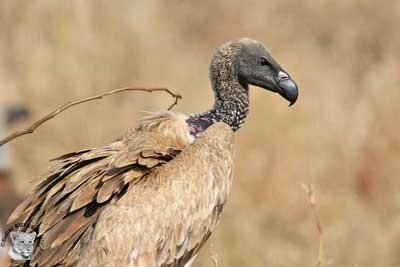 White-backed Vulture - Gyps africanus The eight other genera can be classified in four different groups with relatively close appearance. The Egyptian Vulture (Neophron percnopterus) and the Hooded Vulture (Necrosyrtes monachus) have similar silhouette but different plumage colour. The first one is whitish with black flight feathers, it has feathered head except the bare yellow face and bill and pinkish legs and feet. The second has brown plumage overall with white feathers at base of the foreneck, some grey down on crown and hindneck, bare pink face and bill and greyish legs and feet. 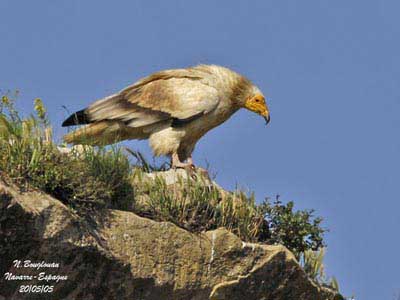 Egyptian Vulture - Neophron percnopterus 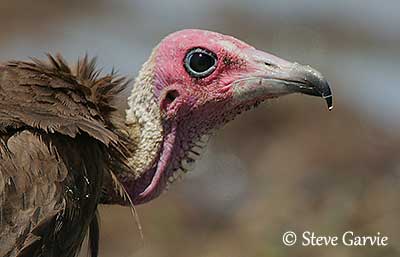 Hooded Vulture - Necrosyrtes monachus Both are fairly small and have slender bills compared to those of the vultures Gyps. For this reason, they are unable to compete with larger species around the carcasses, and only take scraps. However, they can reach the meat between the bones when the other vultures have left. 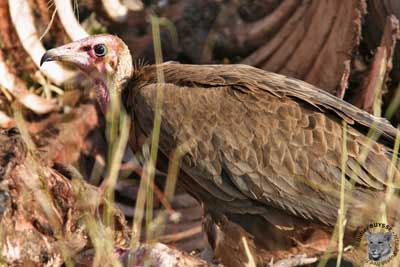 Hooded Vulture Necrosyrtes monachus |
|
|
|
Post by oldcyansilverback on Jan 16, 2023 6:26:43 GMT -5
The Eurasian Black Vulture (Aegypius monachus), the Lappet-faced Vulture (Torgos tracheliotus), the White-headed Vulture (Trigonoceps occipitalis) and the Red-headed Vulture (Sarcogyps calvus) are larger than the previous. They have bare head and neck, from bluish-grey or pink, to white or red. The bare skin may change if the bird is excited, turning brighter or paler. The two first species are larger, with dark brown to blackish plumage. The Lappet-faced Vulture has white underparts, heavily streaked brown on the breast and upper belly, whereas the Eurasian Black Vulture is blackish overall. Its large size makes it dominant at carcasses. 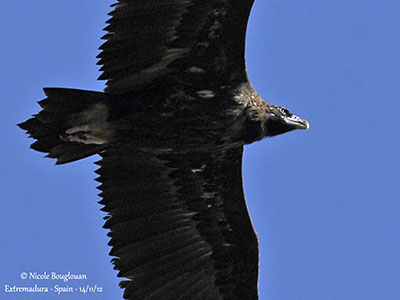 Eurasian Black Vulture Aegypius monachus 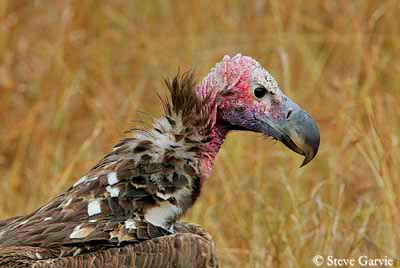 Lappet-faced Vulture - Torgos tracheliotus The two other species are slightly smaller than them, and have dark brown plumage on the upperparts, with paler flight feathers. The White-headed Vulture has black and white underparts, white and pink bare face, reddish bill and pale pink legs and feet, whereas the Red-headed Vulture is dark with white patches on the underparts, red bare head, neck and legs, and black bill. They feed on carrion at large carcasses, and often pirate food from other vultures. www.oiseaux-birds.com/article-old-world-vultures.html |
|
|
|
Post by oldcyansilverback on Jan 16, 2023 6:27:11 GMT -5
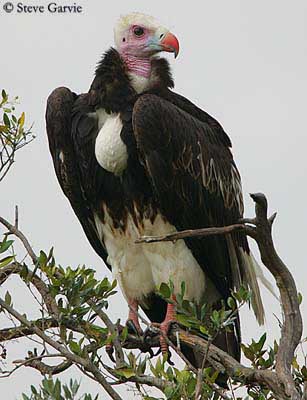 White-headed Vulture - Trigonoceps occipitalis 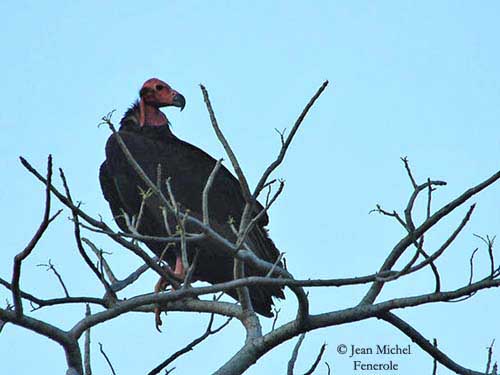 Red-headed Vulture - Sarcogyps calvus The Bearded Vulture or Lammergeier (Gypaetus barbatus) is very large and has different appearance with black wings and tail, and whitish underparts and neck. But they often turn chestnut-orange due to the mineral particles, result of dust-bathing. The whitish head shows black lores, and a kind of black “beard” below the base of the horn-coloured bill. The eyes are yellow with red eye-ring. This species feeds mainly on bones and marrow taken at carcasses. The larger bones are broken by dropping them on rocky surface while flying. 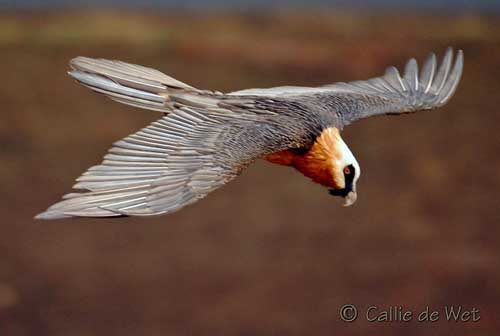 Bearded Vulture - Gypaetus barbatus The last species, the Palm-nut Vulture (Gypohierax angolensis) of which both anatomy and food habits could be intermediate between fish-eagles and vultures, is very different with very contrasted black and white plumage, bare red face, pale grey bill with yellow cere, pale pinkish to yellowish legs and feet. This species feeds primarily on fleshy pericarp of palm-fruits. It also takes fish, crabs, amphibians and molluscs, and medium-sized birds or injured mammals or as carrion. But as some fish-eagles do, it also takes fish from the water surface or by paddling around the shoreline. 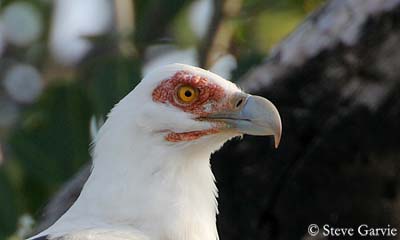 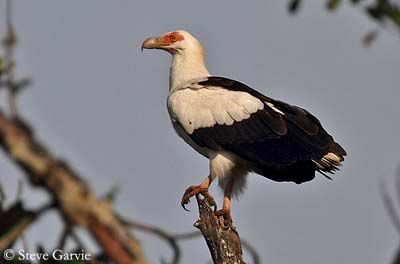 Palm-nut Vulture - Gypohierax angolensis If the chick is usually covered in white down, the juvenile is often brown with duller bare parts, sometimes very dark such as in Bearded Vulture. They need several years to gain the adult plumage and to breed. 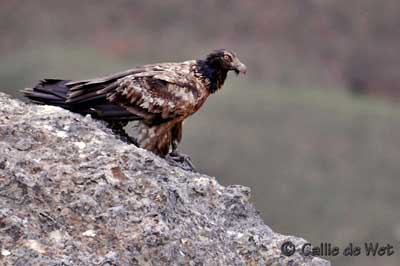 Bearded Vulture - Gypaetus barbatus - Immature 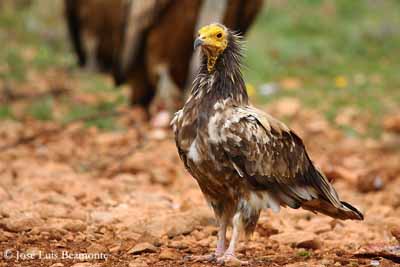 Egyptian Vulture - Neophron percnopterus - Juvenile |
|
|
|
Post by oldcyansilverback on Jan 16, 2023 6:27:48 GMT -5
All the species are scavengers, feeding carrion in variable amount. They do not kill healthy living animals, or only when injured or disabled and weak. They do not have the “tools” for that, they lack the sharp talons, and even their strong hooked bills and their large size do not allow them to kill as eagles and other birds of prey do. The vultures are not very vocal, except around the carcasses when they feed with other vultures. They utter series of grunts and croaks, but also hisses, screeches and high-pitched chatters usually heard during interactions when they are feeding. 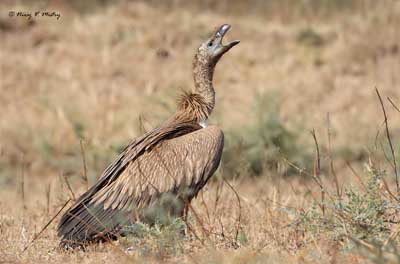 Eurasian Griffon Vulture - Gyps fulvus Except the Palm-nut Vulture, they locate the food thanks to their keen eyesight while flying. They descend little by little, watching around before to reach the food. Disputes often occur around carcasses. The large vultures such as the Eurasian Black Vulture and the Himalayan Vulture are dominant and feed first. Then, other smaller species approach and take the scraps. There are interactions between them, including between the vultures which are waiting for feeding behind the dominant birds. 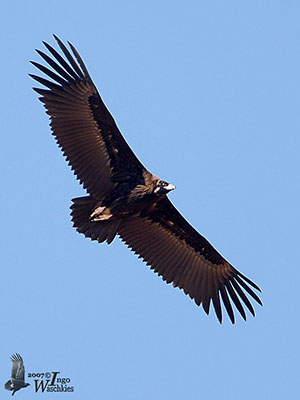 Eurasian Black Vulture -Aegypius monachus 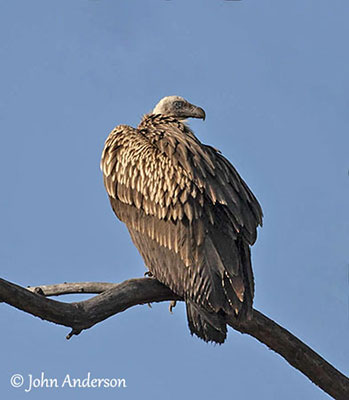 Himalayan Vulture - Gyps himalayensis The threat display is typical, with neck and head held almost horizontally, walking forwards towards the others, but also walking with one leg held forwards while they give hisses at the neighbours. 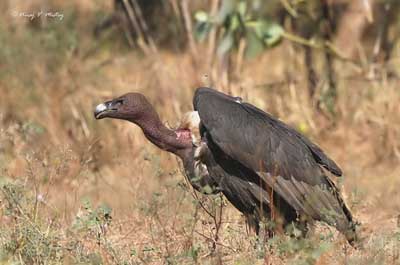 White-rumped Vulture - Gyps bengalensis 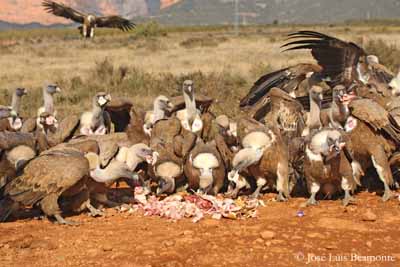 Eurasian Griffon Vulture - Gyps fulvus They take turns around the food. Each species takes particular parts of the carrion, from the best parts of the meat to the bones. A large carcass can be eaten very quickly, sometimes in a few hours. |
|
|
|
Post by oldcyansilverback on Jan 16, 2023 6:28:16 GMT -5
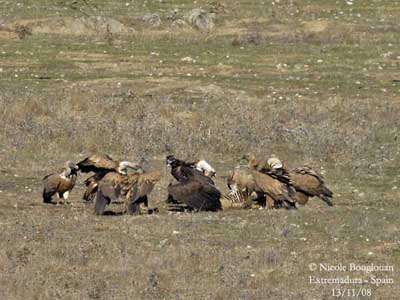 Eurasian Griffon Vulture - Gyps fulvus  Rüppell's Vulture - Gyps rueppellii Vultures usually are gregarious birds, roosting, feeding and breeding together. Several species breed in large or small loose colonies, as well in treetops as in cliff faces, on rocky ledges sometimes with overhanging. Some others nest solitary. 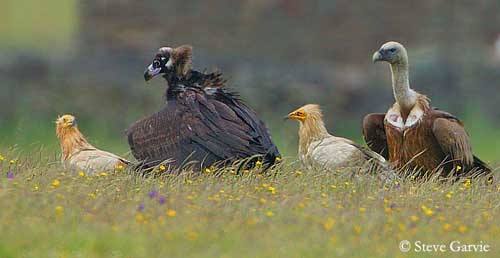 Egyptian vulture Eurasian black vulture Eurasian griffon vulture 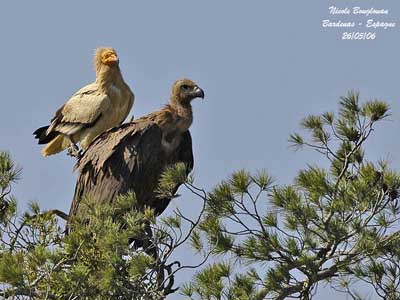 Egyptian Vulture and Eurasian Griffon Vulture 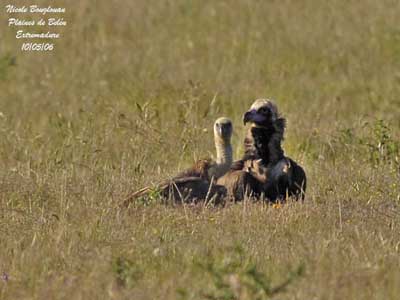 Eurasian Griffon Vulture and Eurasian Black Vulture The nest is a platform, made with sticks and lined with green leaves or dry grass. These large raptors perform aerial displays above the nest-site, flying and soaring together, close to each other. These flights are named “flight in tandem”, and show the birds soaring one above the other or side to side during long periods. They also can flight in circles close to the nest-site. The solitary nesters are territorial and chase away from the nest all the intruders. 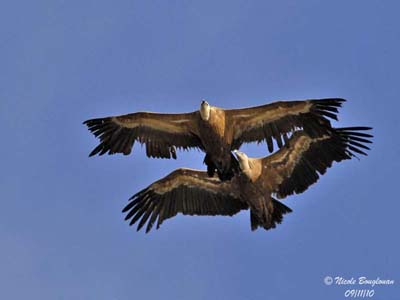 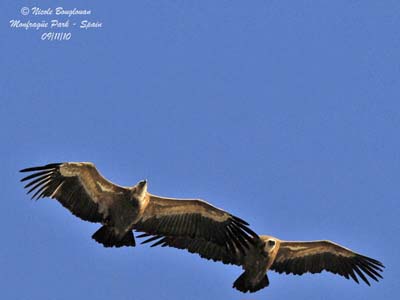 Eurasian Griffon Vulture - Gyps fulvus 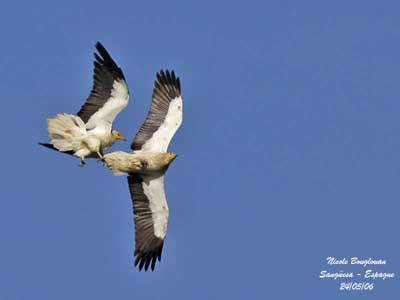 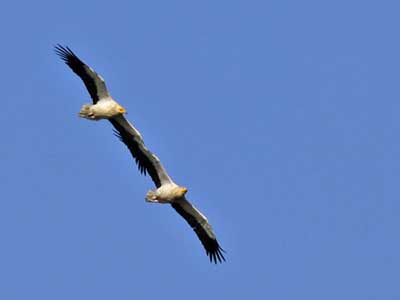 Egyptian Vulture - Neophron percnopterus Usually, a single egg is laid, rarely two. Both parents take turns and incubate. The period can lasts from 42-44 days in smaller species to 58-62 days for the largest vultures. At hatching, the chick is covered in white down. An adult remains at nest with it while the other carries the food. Both parents care the chick and share the nesting duties. |
|
|
|
Post by oldcyansilverback on Jan 16, 2023 6:28:42 GMT -5
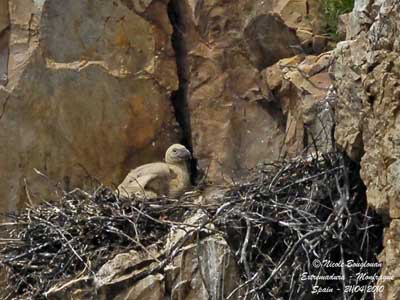 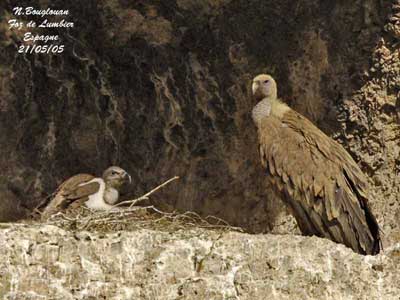 Eurasian Griffon Vulture - Gyps fulvus 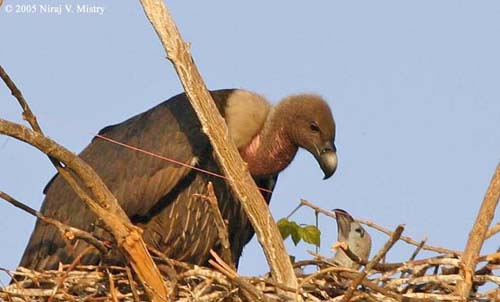 White-rumped Vulture - Gyps bengalensis The nesting period varies from 70-85 to 120-135 days. The young depend on parents during several months, 4 to 12, often until the next breeding season. 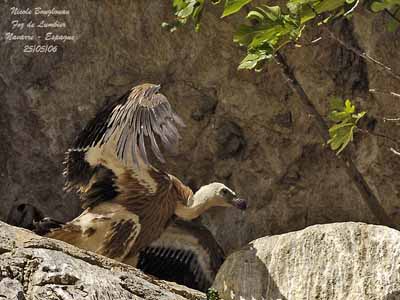 Eurasian Griffon Vulture - Gyps fulvus Young testing its wings before the first flight Vultures are often seen soaring on spread wings at great height, using the thermal currents close to the cliffs to rise in the air. They can soar during long periods and rarely flaps their wings except to take off. 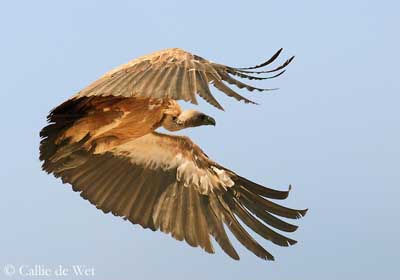 White-backed Vulture - Gyps africanus 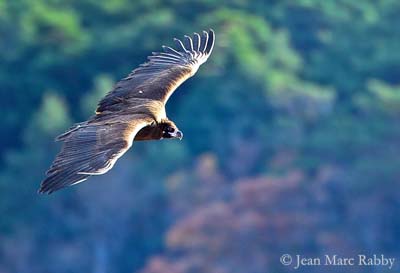 Eurasian Black Vulture - Aegypius monachus 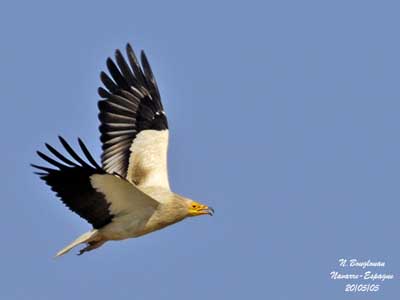 Egyptian Vulture - Neophron percnopterus 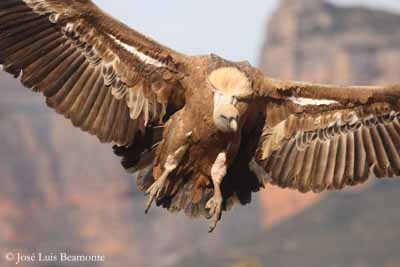 Eurasian Griffon Vulture - Gyps fulvus Some species such as the Himalayan Vulture and the Rüppell’s Vulture are able to fly very high, and to manage the low air pressure and the cold temperature at such high elevation. 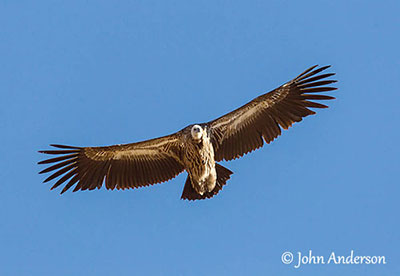 Himalayan Vulture - Gyps himalayensis  Rüppell’s Vulture - Gyps rueppellii The most part of the species are sedentary, others are partially migratory or vagrants, often moving according to the food sources and the weather conditions, or performing altitudinal movements. The young birds often move after the nesting season, as well dispersing over long distances, as following caravans and domestic herds. The Egyptian Vulture from the northern parts of the range migrates, crossing to Africa at Gibraltar. In Eurasian Griffon Vulture, the young birds disperse widely, and can be seasonally nomadic, according to the climate and the movements of the livestock. 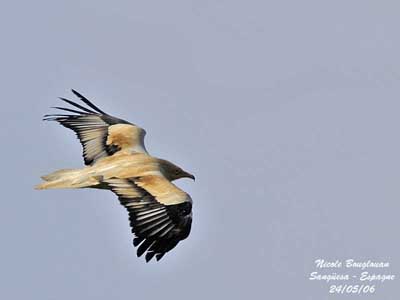 Egyptian Vulture - Neophron percnopterus 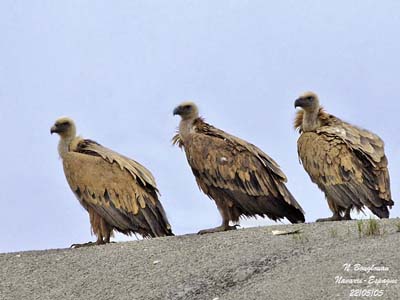 Eurasian Griffon Vulture - Gyps fulvus 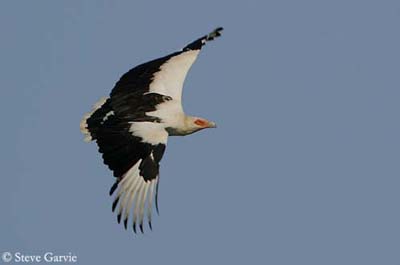 Palm-nut Vulture - Gypohierax angolensis The Old World vultures are present in sub-Saharan Africa, Israel and Arabian Peninsula, southern Europe, Central Asia and India, and Malay Peninsula. They frequent various types of habitats, from open country and savannahs or steppes, to mountainous areas with cliffs, sometimes at high elevation. Some of them favours the areas near water such as the Palm-nut Vulture, others prefers more arid regions such as the Egyptian Vulture. In India, the White-rumped Vulture, the Long-billed Vulture and the Red-headed Vulture can be seen near villages, towns and cities where they gather at rubbish-dumps. 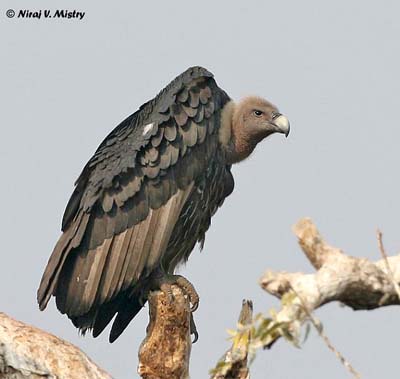 White-rumped Vulture - Gyps bengalensis 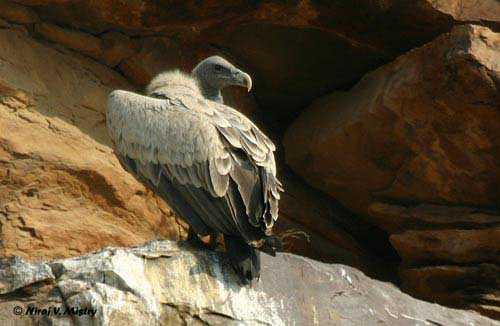 Long-billed Vulture - Gyps indicus The vultures have been and still are persecuted throughout their range, for various reasons. They are accused to kill livestock, and mainly in France and Spain. Maybe they can attack a disabled or weak animal, or a new-born lamb, attracted by the blood of the placenta at the moment of the birth, but they are not able to kill healthy animals because they do not have the tools for that, as previously told. The vultures need to be helped and fed at feed-stations, because they lack carcasses and they are hungry. For this reason, they approach the domestic herds and they are seen closer to villages and towns than formerly. 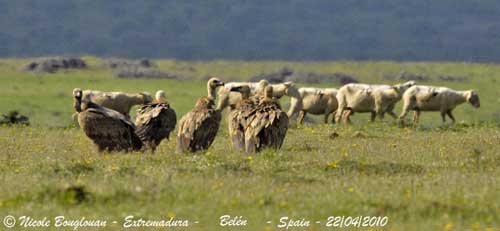 Eurasian Griffon Vulture - Gyps fulvus But in India, another problem occurred some years ago, with the dramatic decrease of the populations of Long-billed Vulture, Slender-billed Vulture (Gyps tenuirostris) and White-rumped Vulture. 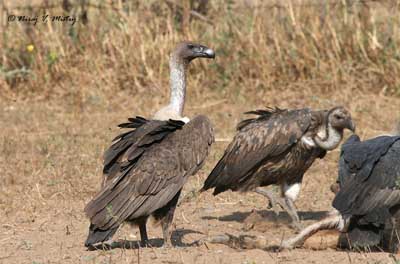 Long-billed Vulture - Gyps indicus 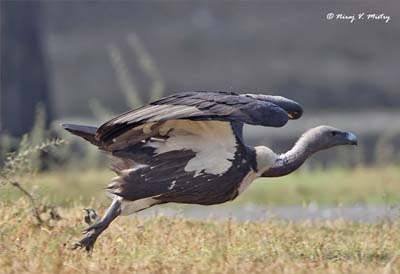 White-rumped Vulture - Gyps bengalensis |
|
|
|
Post by oldcyansilverback on Jan 16, 2023 6:29:11 GMT -5
The raptors were fed with remains of meat and bones given by humans in a large area where some hundreds or thousands of vultures were gathered. But several years ago, the death of large numbers of these raptors involved huge declines. These raptors were eating the flesh of livestock treated with a veterinary drug named Diclofenac. As result, the vultures have been poisoned by this drug, but several years were necessary to find the true reason, and during these years, the drug has continued to kill them. Today, the Diclofenac is forbidden, but how to be sure that it is really stopped? Because the vultures were useful to eat the corpses of the dead in some Indian communities, they were protected by the population, and regularly fed. But now, the lack of these scavengers is sorely felt. The Slender-billed Vulture (Gyps tenuirostris), the Long-billed Vulture or Indian Vulture (Gyps indicus), the White-rumped Vulture (Gyps bengalensis) and the Red-headed Vulture (Sarcogyps calvus) are today Critically Endangered. 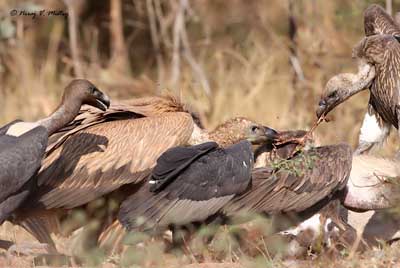 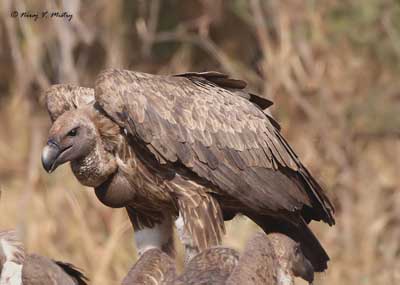 White-rumped Vulture - Gyps bengalensis In Africa, the White-headed Vulture (Trigonoceps occipitalis), the Cape Vulture (Gyps coprotheres) and the Lappet-faced Vulture (Torgos tracheliotus) are classified as Vulnerable. They are threatened by the lack of food due to the changes in farm practices involving less livestock mortalities, poisoned and persecuted and their habitat is destroyed. 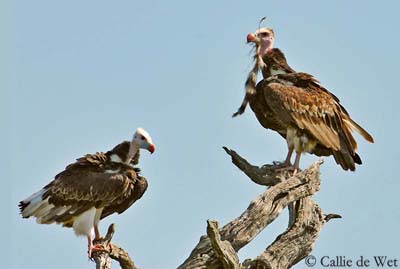 White-headed Vulture - Trigonoceps occipitalis 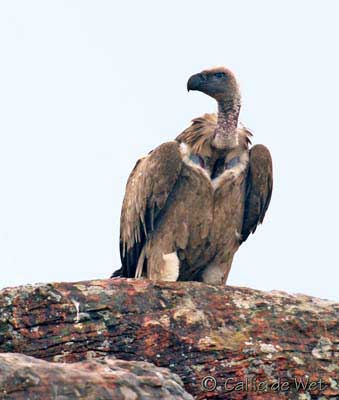 Cape Vulture - Gyps coprotheres 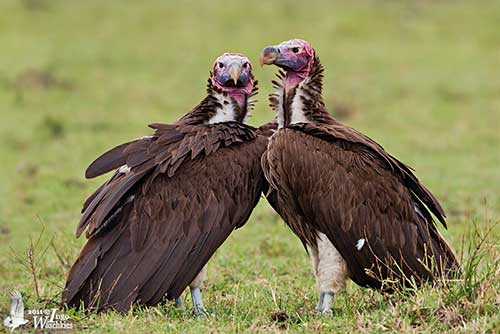 Lappet-faced Vulture - Torgos tracheliotus |
|
|
|
Post by oldcyansilverback on Jan 16, 2023 6:29:52 GMT -5
The Egyptian Vulture (Neophron percnopterus) is evaluated as Endangered for the same reasons. 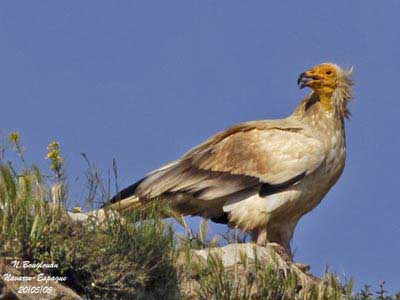 Egyptian Vulture - Neophron percnopterus 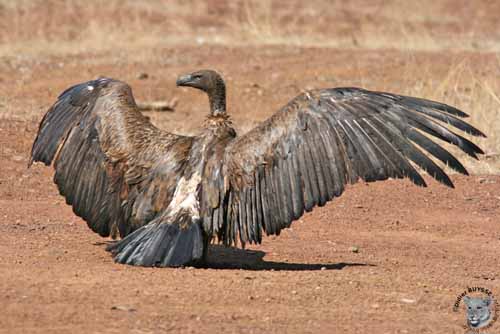 White-backed Vulture-Gyps africanus 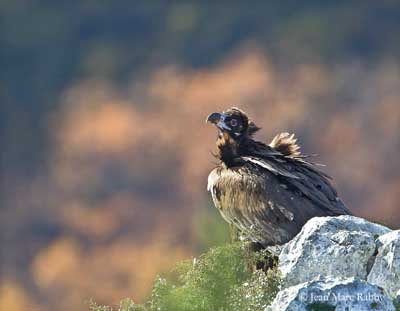 Rüppell’s Vulture - Gyps rueppellii  Eurasian Black Vulture - Aegypius monachus And finally, the Hooded Vulture (Necrosyrtes monachus), the Himalayan Vulture (Gyps himalayensis), the Eurasian Griffon Vulture (Gyps fulvus), the Bearded Vulture (Gypaetus barbatus) and the Palm-nut Vulture (Gypohierax angolensis) are evaluated as Least Concern, in spite of the same threats that in other species but on a much smaller scale. 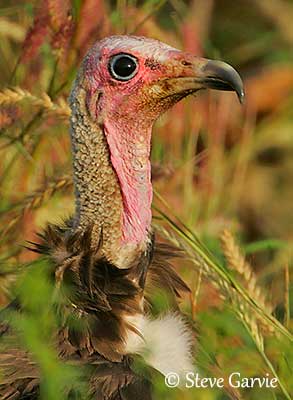 Hooded Vulture - Necrosyrtes monachus 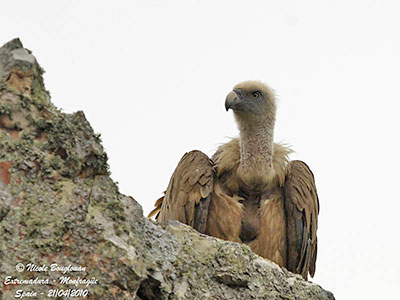 Eurasian Griffon Vulture - Gyps fulvus 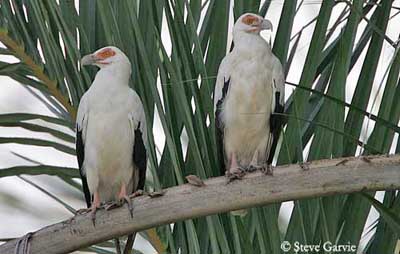 Palm-nut Vulture - Gypohierax angolensis Eurasian Griffon Vulture - Gyps fulvus Protection and conservation projects of the habitat and the raptors are active or in progress. The aerial power lines are in decrease, avoiding collisions while flying. Reserves have been created throughout the most part of the range for the protection of the vultures, and take part in the human education. But numerous problems are far short for being solved, and some species are close to extinction. 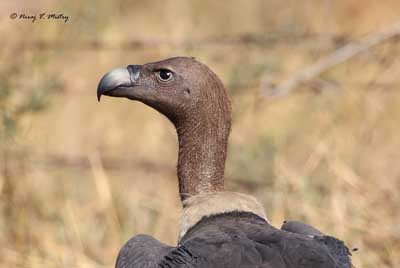 White-rumped Vulture - Gyps bengalensis 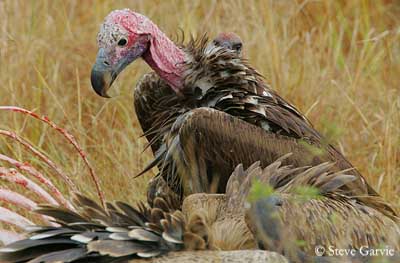 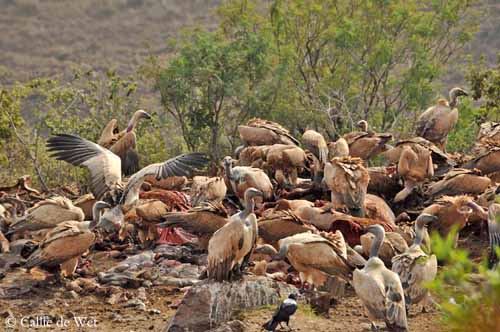 Lappet-faced Vulture - Torgos tracheliotus  Cape Vulture - Gyps coprotheres N evertheless, that is so nice to see these large birds flying in the blue sky, carried away by the thermals along the cliffs which shelter their life or over the wild landscapes providing them something to feed. They are so important for the nature. We cannot continue to kill them because we need them! 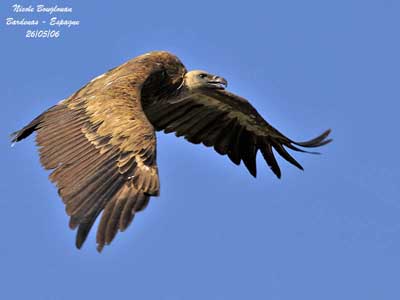 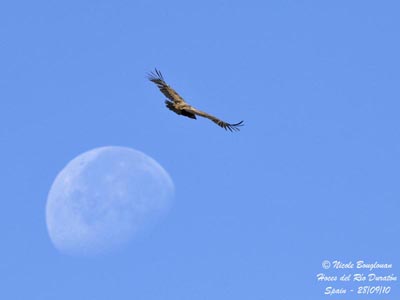 Eurasian Griffon Vulture - Gyps fulvus Sources : BIRDS OF AFRICA SOUTH OF THE SAHARA by Ian Sinclair and Peter Ryan - Princeton University Press Princeton and Oxford - ISBN: 0691118159 ROBERTS BIRDS OF SOUTH AFRICA by G. R. Mc Lachlan and R. Liversidge – The Trustees of the John Voelcker Bird Book Fuund – ISBN: 0620031182 BIRDS OF PREY OF AFRICA AND ITS ISLANDS by Alan and Meg Kemp - Struik Publishers - ISBN: 1770073698 GUIDE DES RAPACES DIURNES – Europe, Afrique du Nord et Moyen-Orient de Benny Génsbol – Delachaux et Niestlé – ISBN : 2603013270 L’ENCYCLOPEDIE MONDIALE DES OISEAUX - Dr Christopher M. Perrins - BORDAS - ISBN: 2040185607 HANDBOOK OF THE BIRDS OF THE WORLD Vol 2 by Josep del Hoyo-Andrew Elliot-Jordi Sargatal - Lynx Edicions - ISBN: 8487334156 BirdLife International (BirdLife International) www.oiseaux-birds.com/article-old-world-vultures.html |
|








































































